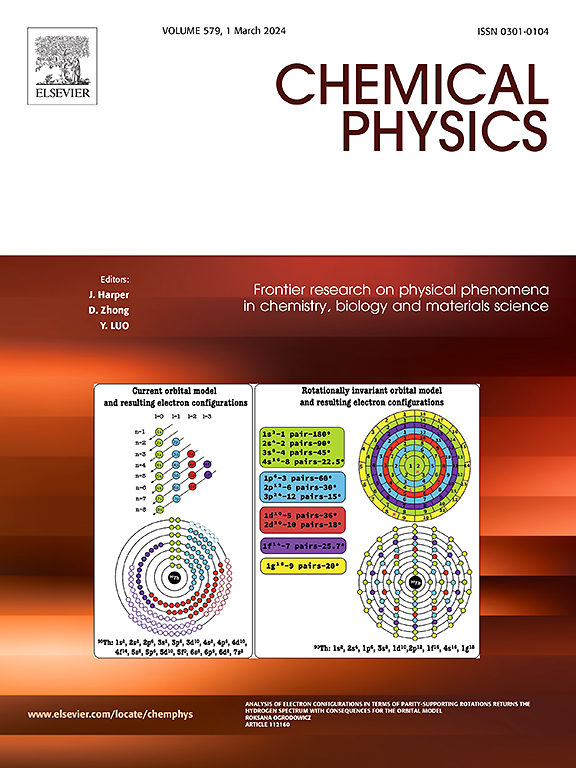Tailoring the physical properties of InSnX3 (X = F, Cl) perovskites via pressure: A path toward sustainable optoelectronics
IF 2
3区 化学
Q4 CHEMISTRY, PHYSICAL
引用次数: 0
Abstract
The present research employs ab-initio modeling via density functional theory to study the key physical characteristics of non-toxic, lead-free metal-based halide perovskites under pressure, aiming to explore their potential applications as photovoltaic materials and in optoelectronic technology. To demonstrate the compounds' supremacy for practical applications, the structural, dynamical, bonding, optoelectronic, elastic, and mechanical adaptabilities of InSnX3 (X = F, Cl) are specifically explored under hydrostatic pressures spanning from 0 to 5 GPa. The structures show excellent accuracy in the lattice constants of InSnF3 (4.728 Å) and InSnCl3 (5.568 Å), supporting the previously released data. The TB-mBJ functional, along with the GGA-PBE scheme, is utilized to obtain a more accurate band gap. The calculated band gap values from both the GGA-PBE and TB-mBJ methods confirm the indirect semiconducting nature of the materials at 0 GPa pressure. However, as pressure increases, the band gap narrows, enhancing the material's conductivity and initiating a transition from a semiconductor to a metallic state. The application of hydrostatic pressure leads to a notable reduction in the electronic band gap, with InSnF3 and InSnCl3 showing initial values of 0.65 eV and 0.69 eV at 0 GPa, respectively, decreasing to 0 eV for both compounds under 5 GPa. Utilizing the TB-mBJ potential improves the precision of the band gap calculation, resulting in values of 1.12 eV for InSnF3 and 1.45 eV for InSnCl3 at 0 GPa. The charge concentration mapping reveals the types of ionic and covalent bonds in In−F(Cl) and Sn−F(Cl), respectively, as well as the reduction in bond lengths induced by external pressure. When stress is applied, both the optical absorption and photoconductivity are significantly improved, demonstrating the applicability of the selected perovskites in a variety of visible and ultraviolet optoelectronic components. In a similar vein, hydrostatic pressure has a major effect on mechanical characteristics while preserving mechanical stability. When pressure is exerted, both perovskites exhibit increased ductility and maintain the Born stability criteria.

通过压力调整InSnX3 (X = F, Cl)钙钛矿的物理性质:通往可持续光电子学的道路
本研究基于密度泛函理论,采用ab-initio模型研究了无铅无毒金属卤化物钙钛矿在压力下的关键物理特性,旨在探索其作为光伏材料和光电子技术的潜在应用。为了证明该化合物在实际应用中的优势,在0至5 GPa的静水压力下,研究了InSnX3 (X = F, Cl)的结构、动力学、键合、光电、弹性和机械适应性。该结构在InSnF3 (4.728 Å)和InSnCl3 (5.568 Å)的晶格常数上具有良好的精度,支持了之前发布的数据。TB-mBJ功能与GGA-PBE方案一起用于获得更精确的带隙。GGA-PBE和TB-mBJ方法计算的带隙值证实了材料在0 GPa压力下的间接半导体性质。然而,随着压力的增加,带隙变窄,增强了材料的导电性,并开始从半导体状态过渡到金属状态。静水压力的施加导致InSnF3和InSnCl3的电子带隙明显减小,在0 GPa下,InSnF3和InSnCl3的初始值分别为0.65 eV和0.69 eV,在5 GPa下,这两种化合物的电子带隙都降至0 eV。利用TB-mBJ电位提高了带隙计算的精度,在0 GPa下,InSnF3的带隙值为1.12 eV, InSnCl3的带隙值为1.45 eV。电荷浓度图分别揭示了in−F(Cl)和Sn−F(Cl)中离子键和共价键的类型,以及外部压力引起的键长减少。当施加应力时,钙钛矿的光吸收和光电导率都得到了显著改善,这表明所选钙钛矿在各种可见和紫外光电元件中的适用性。同样,静水压力在保持机械稳定性的同时对机械特性有重要影响。当施加压力时,两种钙钛矿都表现出增加的延展性并保持玻恩稳定性标准。
本文章由计算机程序翻译,如有差异,请以英文原文为准。
求助全文
约1分钟内获得全文
求助全文
来源期刊

Chemical Physics
化学-物理:原子、分子和化学物理
CiteScore
4.60
自引率
4.30%
发文量
278
审稿时长
39 days
期刊介绍:
Chemical Physics publishes experimental and theoretical papers on all aspects of chemical physics. In this journal, experiments are related to theory, and in turn theoretical papers are related to present or future experiments. Subjects covered include: spectroscopy and molecular structure, interacting systems, relaxation phenomena, biological systems, materials, fundamental problems in molecular reactivity, molecular quantum theory and statistical mechanics. Computational chemistry studies of routine character are not appropriate for this journal.
 求助内容:
求助内容: 应助结果提醒方式:
应助结果提醒方式:


